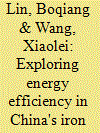|
|
|
Sort Order |
|
|
|
Items / Page
|
|
|
|
|
|
|
| Srl | Item |
| 1 |
ID:
132600


|
|
|
|
|
| Publication |
2014.
|
| Summary/Abstract |
The iron and steel industry is one of the major energy-consuming industries in China. Given the limited research on effective energy conservation in China×s industrial sectors, this paper analyzes the total factor energy efficiency and the corresponding energy conservation potential of China×s iron and steel industry using the excessive energy-input stochastic frontier model. The results show that there was an increasing trend in energy efficiency between 2005 and 2011 with an average energy efficiency of 0.699 and a cumulative energy conservation potential of 723.44 million tons of coal equivalent (Mtce). We further analyze the regional differences in energy efficiency and find that energy efficiency of Northeastern China is high while that of Central and Western China is low. Therefore, there is a concentration of energy conservation potential for the iron and steel industry in the Central and Western areas. In addition, we discover that inefficient factors are important for improving energy conservation. We find that the structural defect in the economic system is an important impediment to energy efficiency and economic restructuring is the key to improving energy efficiency.
|
|
|
|
|
|
|
|
|
|
|
|
|
|
|
|
| 2 |
ID:
158545


|
|
|
|
|
| Summary/Abstract |
Given recent urbanization and land development projects in western China, this study examines how rural villages became part of the expanding municipality of Yinchuan, Ningxia, by focusing on former peasants' occupation transition—their transition into urban employment. Based on the survey and interview data in the outskirts of Yinchuan in 2014 and 2015, the study finds an increase in unemployment rates and the changing distribution of job categories. Quantitative findings highlight the importance of age, gender, and education after land expropriation when agriculture ceases to function as a "safety net," and illustrate the significant effect of pre-expropriation employment but not compensation from land development per se. Such findings are explained and enriched by analyses of in-depth interviews, that most available jobs for older and less educated peasants are unstable and low-end work in construction and service sectors created by urbanization. There are also limited chances to establish and develop one's career, either for those who had prior market experiences and financial capabilities to start private businesses, or for those received heavy education investment from their families in a hope of obtaining clerical or professional jobs. Men are more active in pursuing private businesses and formal white-collar jobs by pooling together the family resources, and women are underrepresented in both sectors. Speaking to the debates on the labor market outcomes for former peasants in urbanization, this study illustrates the emerging opportunities of entrepreneur-ship and economic mobility and the prevalent segregation and discrimination in labor markets.
|
|
|
|
|
|
|
|
|
|
|
|
|
|
|
|
| 3 |
ID:
140939


|
|
|
|
|
| Summary/Abstract |
Before the 1937 Japanese invasion of China, almost all Chinese leaders and intellectuals believed that the large-scale agricultural settlement of China's western peripheries would rapidly deliver extensive economic and social benefits. At the onset of the war, many officials from the western provinces pressed the central government to fund programmes to allow millions of refugees from Japanese-occupied territory to settle on and cultivate ‘wasteland’ (huang) on the peripheries of their jurisdictions. Influenced more by pre-War ideology than the demands of the War, central and provincial governments established ‘land settlement and cultivation zones’ (kenzhiqu) in these provinces. However, these ventures were much less well supported than their proponents had hoped. This was not only because the War strained government finances—funding for kenzhiqu was always limited relative to support for agricultural cooperatives—but also partly because kenzhiqu attempts to recruit settlers clashed with the acute labour shortage in core zones of unoccupied China, which led to the abandonment of already cultivated land there, and partly because of the mistrust between central and regional governments. Nonetheless, wartime advocacy for more land cultivation in the Northwest did have important repercussions, leading to a renewed interest in penal colonies.
|
|
|
|
|
|
|
|
|
|
|
|
|
|
|
|
| 4 |
ID:
099322


|
|
|
|
|
| Publication |
2010.
|
| Summary/Abstract |
China is striving for coordinated regional economic development and to solve the energy shortage in eastern China through a western China development plan with one focus being energy development and west to east energy transfer. This paper describes Western China Sustainable Energy Development Model (WSED) to evaluate various energy development scenarios for western China. The model includes a Western China MARKAL model, a Computable General Equilibrium Model for Western China (WCGE), and an Energy Service Demand Projection Model (ESDP). The ESDP provides energy service demand projections for the Western China MARKAL model, while the WCGE provides macroeconomic inputs for the ESDP and analyzes the impact of different energy development scenarios on western China economy. A reference scenario and several different west to east energy transfer scenarios with and without consideration of the water constraints and the endogenous technology learning are presented. The modeling describes the energy consumption, carbon emissions, water consumption, energy investment cost, and the impact on western China GDP of the different scenarios through the year 2050. These results have implications on sustainable energy development policies and sustainable west to east energy transfer strategies.
|
|
|
|
|
|
|
|
|
|
|
|
|
|
|
|
|
|
|
|
|